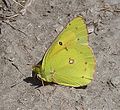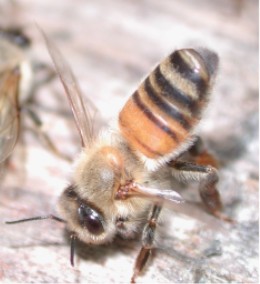
A pheromone is a secreted or excreted chemical factor that triggers a social response in members of the same species. Pheromones are chemicals capable of acting like hormones outside the body of the secreting individual, to affect the behavior of the receiving individuals. There are alarm pheromones, food trail pheromones, sex pheromones, and many others that affect behavior or physiology. Pheromones are used by many organisms, from basic unicellular prokaryotes to complex multicellular eukaryotes. Their use among insects has been particularly well documented. In addition, some vertebrates, plants and ciliates communicate by using pheromones. The ecological functions and evolution of pheromones are a major topic of research in the field of chemical ecology.

The Pieridae are a large family of butterflies with about 76 genera containing about 1,100 species, mostly from tropical Africa and tropical Asia with some varieties in the more northern regions of North America and Eurasia. Most pierid butterflies are white, yellow, or orange in coloration, often with black spots. The pigments that give the distinct coloring to these butterflies are derived from waste products in the body and are a characteristic of this family. The family was created by William John Swainson in 1820.
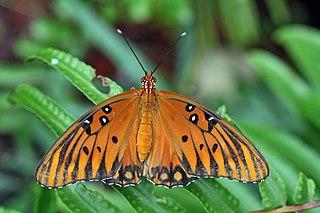
The Gulf fritillary or passion butterfly is a bright orange butterfly in the subfamily Heliconiinae of the family Nymphalidae. That subfamily was formerly set apart as a separate family, the Heliconiidae. The Heliconiinae are "longwing butterflies", which have long, narrow wings compared to other butterflies.

Zerene eurydice, the California dogface butterfly, belongs to the family Pieridae and is a sister genus to Colias.The Zerene eurydice and the Colias both share the "characteristic of having yellow-orange and black wing coordination." Additionally the,"Colias and Zerene eurydice males have bright UV patterns on their wings." There are only two species of the Zerene, the Zerene eurydice, and the Zerene cesonia, also known as the Southern dogface. A study that collected mitochondrial DNA from various Colias butterfly species found that Z. eurydice had decreased divergence from the ingroup, highlighting how closely related these two genera are. This species is endemic to California, and is California's state insect. The California dogface butterfly varies in its wing color and pattern.

Anthocharis cardamines, the orange tip, is a butterfly in the family Pieridae, which contains about 1,100 species. A. cardamines is mainly found throughout Europe and temperate Asia (Palearctic) The males feature wings with a signature orange pigmentation, which is the origin of A. cardamines' common name.

Gonepteryx rhamni, commonly named the common brimstone, is a butterfly of the family Pieridae. It lives throughout the Palearctic zone and is commonly found across Europe, Asia, and North Africa. Across much of its range, it is the only species of its genus, and is therefore simply known locally as the brimstone. Its wing span size is 60–74 mm (2.4–2.9 in). It should not be confused with the brimstone moth Opisthograptis luteolata.

Heliconius charithonia, the zebra longwing or zebra heliconian, is a species of butterfly belonging to the subfamily Heliconiinae of the family Nymphalidae. It was first described by Carl Linnaeus in his 1767 12th edition of Systema Naturae. The boldly striped black and white wing pattern is aposematic, warning off predators.

Colias croceus, clouded yellow, is a small butterfly of the family Pieridae, the yellows and whites.

Colias alfacariensis, Berger's clouded yellow, is a butterfly of the family Pieridae. It was separated from the pale clouded yellow, C. hyale, in 1905. Berger's clouded yellow is a Palearctic species (South and Central Europe, South Russia, Russian Far East, Siberia Central Asia and temperate China also Asia Minor, Caucasus and Transcaucasia.

The queen butterfly is a North and South American butterfly in the family Nymphalidae with a wingspan of 80–85 mm. It is orange or brown with black wing borders and small white forewing spots on its dorsal wing surface, and reddish ventral wing surface fairly similar to the dorsal surface. The ventral hindwings have black veins and small white spots in a black border. The male has a black androconial scent patch on its dorsal hindwings. It can be found in meadows, fields, marshes, deserts, and at the edges of forests.

Colias is a genus of butterflies in the family Pieridae. They are often called clouded yellows in the Palearctic and sulphurs in North America. The closest living relative is the genus Zerene, which is sometimes included in Colias.

Cosmophasis umbratica is a species of jumping spider found in South and Southeast Asia. They are members of the family Salticidae and the genus Cosmophasis. They are commonly spotted on green vegetation. C. umbratica shows extreme dimorphism when viewed under UV light: males reflect UV on all body parts that are displayed during intraspecific interaction, while females and juveniles do not reflect UV at all. It seems that C. umbratica uses this in sexual signaling. A similar phenomenon is found in some butterflies. For example, several species of Colias and Gonepteryx, both of the family Pieridae, also display sexual signaling.

Pontia protodice, the checkered white or southern cabbage butterfly, is a common North American butterfly in the family Pieridae. Its green larva is a type of cabbage worm.

Colias philodice, the common sulphur or clouded sulphur, is a North American butterfly in the family Pieridae, subfamily Coliadinae.

Colias tyche, the Booth's sulphur or pale Arctic clouded yellow, is a butterfly in the family Pieridae. It is found from Baffin Island west along the Hudson Bay and arctic coasts of the Nunavut and Northwest Territories mainland and the southern tier of Arctic Islands to northern Yukon, Alaska, and Eurasia.
Butterflies, or members of the Papilionoidea superfamily, use two ultraviolet signals, UV reflectance or absorbance as a communication system. The ultraviolet region is the part of the electromagnetic spectrum between 10 nm and 400 nm in wavelength. Sensitivity to this region provides butterflies several benefits such as nectar guides for nectar, but it also provides a private communication channel unavailable to predators. With this secure line, butterflies are able to facilitate mating behavior and sex recognition.
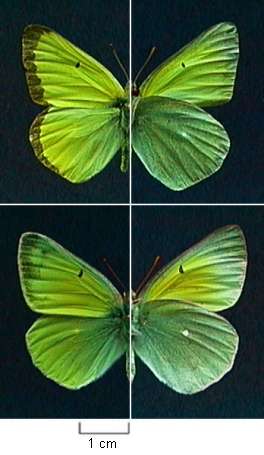
Colias alexandra, the Queen Alexandra's sulphur, Alexandra sulphur, or ultraviolet sulfur, is a butterfly in the family Pieridae found in western North America. Its range includes Alaska to the Northwest Territories and south to Arizona and New Mexico.

Hair-pencils and coremata are pheromone signaling structures present in lepidopteran males. Males use hair-pencils in courtship behaviors with females. The pheromones they excrete serve as both aphrodisiacs and tranquilizers to females as well as repellents to conspecific males. Hair-pencil glands are stored inside the male until courtship begins, at which point they are forced out of the body by sclerotized levers present on the abdomen. Coremata are very similar structures. Their exact definition is confused by early descriptions but they are more specifically defined as the internal, glandular, eversible structures that bear the hair-pencils and can be voluntarily inflated with hemolymph or air.
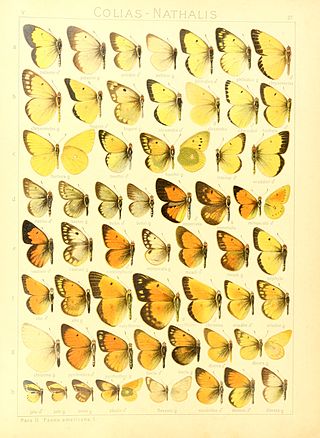
Colias flaveola is a butterfly in the family Pieridae. It is found in the Tropical Andes subregion of the Neotropical realm.




